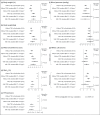Comparison of Efficacy and Safety of Liraglutide 3.0 mg in Individuals with BMI above and below 35 kg/m²: A Post-hoc Analysis
- PMID: 29145215
- PMCID: PMC5836203
- DOI: 10.1159/000478099
Comparison of Efficacy and Safety of Liraglutide 3.0 mg in Individuals with BMI above and below 35 kg/m²: A Post-hoc Analysis
Abstract
Objective: To investigate whether the efficacy and safety of liraglutide 3.0 mg differed between two subgroups, BMI 27 to <35 and BMI ≥ 35 kg/m², in individuals without and with type 2 diabetes (T2D).
Methods: A post-hoc analysis of two 56-week, randomized, double-blind, placebo-controlled trials (SCALE Obesity and Prediabetes; SCALE Diabetes). Subgroup differences in treatment effects of liraglutide 3.0 mg were evaluated by testing the interaction between treatment group and baseline BMI subgroup.
Results: Significantly greater weight loss (0-56 weeks) was observed with liraglutide 3.0 mg versus placebo in all patient groups while on treatment. There was no evidence that the weight-lowering effect of liraglutide 3.0 mg differed between BMI subgroups (interaction p > 0.05). Similarly, for most secondary endpoints significantly greater improvements were observed with liraglutide 3.0 mg versus placebo, with no indication treatment effects differing between subgroups. The safety profile of liraglutide 3.0 mg was broadly similar across BMI subgroups.
Conclusion: This post-hoc analysis did not indicate any differences in the treatment effects, or safety profile, of liraglutide 3.0 mg for individuals with BMI 27 to <35 or ≥35 kg/m². Liraglutide 3.0 mg can therefore be considered for individuals with a BMI of ≥35 as well as for those with a BMI of 27 to <35 kg/m².
Keywords: Efficacy; Liraglutide; Obesity; Safety.
© 2017 The Author(s) Published by S. Karger GmbH, Freiburg.
Figures


Similar articles
-
EFFECTS OF LIRAGLUTIDE 3.0 MG ON WEIGHT AND RISK FACTORS IN HISPANIC VERSUS NON-HIPANIC POPULATIONS: SUBGROUP ANALYSIS FROM SCALE RANDOMIZED TRIALS.Endocr Pract. 2016 Nov;22(11):1277-1287. doi: 10.4158/EP151181.OR. Epub 2016 Aug 2. Endocr Pract. 2016. PMID: 27482610 Clinical Trial.
-
Efficacy and safety of liraglutide 3.0 mg for weight management are similar across races: subgroup analysis across the SCALE and phase II randomized trials.Diabetes Obes Metab. 2016 Apr;18(4):430-5. doi: 10.1111/dom.12632. Epub 2016 Feb 11. Diabetes Obes Metab. 2016. PMID: 26744025 Free PMC article. Clinical Trial.
-
Effects of liraglutide on visceral and ectopic fat in adults with overweight and obesity at high cardiovascular risk: a randomised, double-blind, placebo-controlled, clinical trial.Lancet Diabetes Endocrinol. 2021 Sep;9(9):595-605. doi: 10.1016/S2213-8587(21)00179-0. Epub 2021 Aug 3. Lancet Diabetes Endocrinol. 2021. PMID: 34358471 Clinical Trial.
-
[Pharmacotherapy for obesity].Ugeskr Laeger. 2016 Oct 31;178(44):V06160406. Ugeskr Laeger. 2016. PMID: 27808050 Review. Danish.
-
The efficacy and safety of liraglutide in the obese, non-diabetic individuals: a systematic review and meta-analysis.Afr Health Sci. 2019 Sep;19(3):2591-2599. doi: 10.4314/ahs.v19i3.35. Afr Health Sci. 2019. PMID: 32127832 Free PMC article.
Cited by
-
GABA neurons in the nucleus tractus solitarius express GLP-1 receptors and mediate anorectic effects of liraglutide in rats.Sci Transl Med. 2020 Mar 4;12(533):eaay8071. doi: 10.1126/scitranslmed.aay8071. Sci Transl Med. 2020. PMID: 32132220 Free PMC article.
-
Blood Pressure-Lowering Therapy.Handb Exp Pharmacol. 2022;270:25-45. doi: 10.1007/164_2020_372. Handb Exp Pharmacol. 2022. PMID: 32728994
-
Weight loss and persistence with liraglutide 3.0 mg by obesity class in the real-world effectiveness study in Canada.Obes Sci Pract. 2020 May 9;6(4):439-444. doi: 10.1002/osp4.420. eCollection 2020 Aug. Obes Sci Pract. 2020. PMID: 32874678 Free PMC article.
-
The new obesity classification based on weight history is not proposed as a guideline.Arch Endocrinol Metab. 2022 Nov 17;66(6):936-937. doi: 10.20945/2359-3997000000571. Arch Endocrinol Metab. 2022. PMID: 36394490 Free PMC article. No abstract available.
-
Obesity and Type 2 Diabetes: Adiposopathy as a Triggering Factor and Therapeutic Options.Molecules. 2023 Mar 30;28(7):3094. doi: 10.3390/molecules28073094. Molecules. 2023. PMID: 37049856 Free PMC article. Review.
References
-
- Must A, Spadano J, Coakley EH, Field AE, Colditz G, Dietz WH. The disease burden associated with overweight and obesity. JAMA. 1999;282:1523–1529. - PubMed
Publication types
MeSH terms
Substances
LinkOut - more resources
Full Text Sources
Other Literature Sources
Medical

